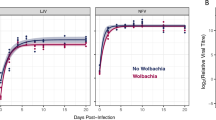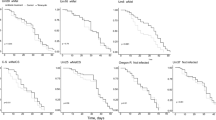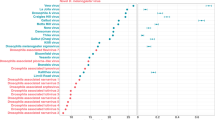Abstract
Maternally inherited endosymbionts that manipulate the reproduction of their insect host are very common. Aside from the reproductive manipulation they produce, the fitness of these symbionts depends in part on the direct impact they have on the female host. Although this parameter has commonly been investigated for single infections, it has much more rarely been established in dual infections. We here establish the direct effect of infection with two different symbionts exhibiting different reproductive manipulation phenotypes, both alone and in combination, in the fruit fly Drosophila melanogaster. This species carries a cytoplasmic incompatibility inducing Wolbachia and a male-killing Spiroplasma, occurring as single or double (co-) infections in natural populations. We assessed direct fitness effects of these bacteria on their host, by comparing larval competitiveness and adult fecundity of uninfected, Wolbachia, Spiroplasma and Wolbachia–Spiroplasma co-infected females. We found no effect of infection status on the fitness of females for both estimates, that is, no evidence of any benefits or costs to either single or co-infection. This leads to the conclusion that both bacteria probably have other sources of benefits to persist in D. melanogaster populations, either by means of their reproductive manipulations (fitness compensation from male death in Spiroplasma infection and cytoplasmic incompatibility in Wolbachia infection) or by positive fitness interactions on other fitness components.
Similar content being viewed by others
References
H. Anbutsu T. Fukatsu (2003) ArticleTitlePopulation dynamics of male-killing and non-male-killing spiroplasmas in Drosophila melanogaster Appl. Environ. Microbiol. 69 1428–1434 Occurrence Handle12620825 Occurrence Handle1:CAS:528:DC%2BD3sXitlClsr4%3D Occurrence Handle10.1128/AEM.69.3.1428-1434.2003
C. Bandi A.M. Dunn G.D.D. Hurst T. Rigaud (2001) ArticleTitleInherited microorganisms, sex-specific virulence and reproductive parasitism Trends Parasitol. 17 88–94 Occurrence Handle11228015 Occurrence Handle1:STN:280:DC%2BD3Mris1WktA%3D%3D Occurrence Handle10.1016/S1471-4922(00)01812-2
S.R. Bordenstein J.H. Werren (2000) ArticleTitleDo Wolbachia influence fecundity in Nasonia vitripennis? Heredity 84 54–62 Occurrence Handle10692011 Occurrence Handle10.1046/j.1365-2540.2000.00637.x
L. Cosmides J. Tooby (1981) ArticleTitleCytoplasmic inheritance and intragenomic conflict J. Theor. Biol. 89 83–129 Occurrence Handle7278311 Occurrence Handle1:CAS:528:DyaL3MXhs12rtbw%3D Occurrence Handle10.1016/0022-5193(81)90181-8
S.L. Dobson W. Rattanadechakul E.J. Marsland (2004) ArticleTitleFitness advantage and cytoplasmic incompatibility in Wolbachia single- and superinfected Aedes albopictus Heredity 93 135–142 Occurrence Handle15127087 Occurrence Handle1:STN:280:DC%2BD2czntVOlsg%3D%3D Occurrence Handle10.1038/sj.hdy.6800458
M.A. Ebbert (1991) ArticleTitleThe interaction phenotype in the Drosophila willistoni–Spiroplasma symbiosis Evolution 45 971–988 Occurrence Handle10.2307/2409703
M.A. Ebbert (1995) ArticleTitleVariable effects of crowding on Drosophila hosts of male-lethal and non-male-lethal spiroplasmas in laboratory populations Heredity 74 227–240 Occurrence Handle7706112
W.G. Eberhard (1980) ArticleTitleEvolutionary consequences of intracellular organelle competition Q. Rev. Biol. 55 231–249 Occurrence Handle7208806 Occurrence Handle1:CAS:528:DyaL3cXmtlarsL4%3D Occurrence Handle10.1086/411855
J. Engelstädter A. Telschow P. Hammerstein (2004) ArticleTitleInfection dynamics of different Wolbachia-types within one host population J. Theor. Biol. 231 345–355 Occurrence Handle15501467 Occurrence Handle10.1016/j.jtbi.2004.06.029
P.W. Ewald (1987) ArticleTitleTransmission modes and evolution of the parasitism-mutualism continuum Ann. NY Acad. Sci. 503 295–306 Occurrence Handle3304078 Occurrence Handle1:STN:280:DyaL2s3pslWnug%3D%3D
P.E.M. Fine (1975) ArticleTitleDynamics of symbiote-dependent cytoplasmic incompatibility in culicine mosquitos J. Invert. Pathol. 31 10–18 Occurrence Handle10.1016/0022-2011(78)90102-7
S.A. Frank (1998) ArticleTitleDynamics of cytoplasmic incompatibility with multiple Wolbachia infections J. Theor. Biol. 192 213–218 Occurrence Handle9735249 Occurrence Handle10.1006/jtbi.1998.0652
A.J. Fry D.M. Rand (2002) ArticleTitle Wolbachia interactions that determine Drosophila melanogaster survival Evolution 56 1976–1981 Occurrence Handle12449484 Occurrence Handle10.1554/0014-3820(2002)056[1976:WITDDM]2.0.CO;2
A.J. Fry M.R. Palmer D.M. Rand (2004) ArticleTitleVariable fitness effects of Wolbachia infection in Drosophila melanogaster Heredity 93 379–389 Occurrence Handle15305172 Occurrence Handle1:STN:280:DC%2BD2cvnvFGjsA%3D%3D Occurrence Handle10.1038/sj.hdy.6800514
Genstat 7 Committee, 2003. Genstat 7 release 2. Copyright 2003. Lawes Agricultural Trust (IACR, Rothamsted)
Goedhart P.W. & J.T.N.M. Thissen, (eds), 2003. Biometris Procedure Library for Genstat 7th Edition. Wageningen UR, The Netherlands
W. Harcombe A.A. Hoffmann (2004) ArticleTitle Wolbachia effects in Drosophila melanogaster: in search of fitness benefits J. Inv. Pathol. 87 45–50 Occurrence Handle1:STN:280:DC%2BD2critFCgtw%3D%3D Occurrence Handle10.1016/j.jip.2004.07.003
M. Hiroki Y. Tagami K. Miura Y. Kato (2004) ArticleTitleMultiple infection with Wolbachia inducing different reproductive manipulations in the butterfly Eurema hecabe Proc. R. Soc. Lond. B 271 1751–1755 Occurrence Handle10.1098/rspb.2004.2769
A.A. Hoffmann D.J. Clancy E. Merton (1994) ArticleTitleCytoplasmic incompatibility in Australian populations of Drosophila melanogaster Genetics 136 993–999 Occurrence Handle8005448 Occurrence Handle1:STN:280:DyaK2c3nsVSnug%3D%3D
A.A. Hoffmann M. Hercus H. Dagher (1998) ArticleTitlePopulation dynamics of the Wolbachia infection causing cytoplasmic incompatibility in Drosophila melanogaster Genetics 148 221–231 Occurrence Handle9475734 Occurrence Handle1:STN:280:DyaK1c7jtlyrsw%3D%3D
G.D.D. Hurst F.M. Jiggins (2000) ArticleTitleMale-killing bacteria in insects: Mechanisms, incidence, and implications Emerging Infect. Dis. 6 329–336 Occurrence Handle10905965 Occurrence Handle1:STN:280:DC%2BD3cvhtVentA%3D%3D Occurrence Handle10.3201/eid0604.000402
R. Ihaka R. Gentleman (1996) ArticleTitleR: a language for data analysis and graphics J. Comp. Graph. Stat. 5 299–314 Occurrence Handle10.2307/1390807
H. Ikeda (1970) ArticleTitleCytoplasmically-inherited ‘sex-ratio’ condition in natural and experimental populations of Drosophila bifasciata Genetics 65 311–333 Occurrence Handle5474831 Occurrence Handle1:STN:280:DyaE3M%2Fhs1Oluw%3D%3D
F.M. Jiggins J.P. Randerson G.D.D. Hurst M.E.N. Majerus (2002) ArticleTitleHow can sex ratio distorters reach extreme prevalences? Male-killing Wolbachia are not suppressed and have near-perfect vertical transmission efficiency in Acraea encedon Evolution 56 2290–2295 Occurrence Handle12487358 Occurrence Handle10.1554/0014-3820(2002)056[2290:HCSRDR]2.0.CO;2
M. Lipsitch M.A. Nowak D. Ebert R.M. May (1995) ArticleTitleThe population dynamics of vertically and horizontally transmitted parasites Proc. R. Soc. Lond. B 260 321–327 Occurrence Handle1:STN:280:DyaK2Mzlslelug%3D%3D
P. McCullagh J.A. Nelder (1989) Generalized Linear Models. Monographs on Statistics and Applied Probability Chapman & Hall London
E.A. McGraw D.J. Merritt J.N. Droller S.L. O’Neill ( 2002) ArticleTitle Wolbachia density and virulence attenuation after transfer into a novel host Proc. Natl. Acad. Sci. USA 99 2918–2923 Occurrence Handle11880639 Occurrence Handle10.1073/pnas.052466499 Occurrence Handle1:CAS:528:DC%2BD38Xit1CrtbY%3D
I. McMillan M. Fitz-Earle L. Butler D.S. Robson (1970) ArticleTitleQuantitative genetics of fertility II. Lifetime egg production of Drosophila melanogaster – experimental Genetics 65 355–369 Occurrence Handle5482368 Occurrence Handle1:STN:280:DyaE3M%2FjvVyktw%3D%3D
K.T. Min S. Benzer (1997) ArticleTitle Wolbachia, normally a symbiont of Drosophila, can be virulent, causing degeneration and early death Proc. Natl. Acad. Sci. USA 94 10792–10796 Occurrence Handle9380712 Occurrence Handle1:CAS:528:DyaK2sXmtlCit70%3D Occurrence Handle10.1073/pnas.94.20.10792
H. Montenegro L.B. Klaczko (2004) ArticleTitleLow temperature cure of a male killing agent in Drosophila melanogaster J. Invert. Pathol. 86 50–51 Occurrence Handle1:STN:280:DC%2BD2c3kslGjtQ%3D%3D Occurrence Handle10.1016/j.jip.2004.03.004
H. Montenegro W.N. Souza D.S. Leite L.B. Klaczko (2000) ArticleTitleMale-killing selfish cytoplasmic element causes sex-ratio distortion in Drosophila melanogaster Heredity 85 465–470 Occurrence Handle11122425 Occurrence Handle10.1046/j.1365-2540.2000.00785.x
H. Montenegro V.N. Solferini L.B. Klaczko G.D.D. Hurst (2005) ArticleTitleMale-killing Spiroplasma naturally infecting Drosophila melanogaster Insect Mol. Biol. 14 281–287 Occurrence Handle15926897 Occurrence Handle1:CAS:528:DC%2BD2MXlt1Cmsbc%3D Occurrence Handle10.1111/j.1365-2583.2005.00558.x
L. Mouton F. Dedeine H. Henri M. Boulétreau N. Profizi F. Vavre (2004) ArticleTitleVirulence, multiple infections and regulation of symbiotic population in the Wolbachia–Asobara tabida symbiosis Genetics 168 181–189 Occurrence Handle15454536 Occurrence Handle10.1534/genetics.104.026716
K. Olsen K.T. Reynolds A.A. Hoffmann (2001) ArticleTitleA field cage test of the effects of the endosymbiont Wolbachia on Drosophila melanogaster Heredity 86 731–737 Occurrence Handle11595053 Occurrence Handle1:STN:280:DC%2BD3MrkvVyrsQ%3D%3D Occurrence Handle10.1046/j.1365-2540.2001.00892.x
R Development Core Team, 2004. R: A language and environment for statistical computing. R Foundation for Statistical Computing, Vienna, Austria. ISBN 3-900051-07-0, URL http://www.R-project.org
M. Reuter L. Keller (2003) ArticleTitleHigh levels of multiple Wolbachia infection and recombination in the ant Formica exsecta Mol. Biol. Evol. 20 748–753 Occurrence Handle12679529 Occurrence Handle1:CAS:528:DC%2BD3sXkvFCgu7w%3D Occurrence Handle10.1093/molbev/msg082
K. Reynolds A.A. Hoffmann (2002) ArticleTitleMale age, host effects and the weak expression or non-expression of cytoplasmic incompatibility in Drosophila strains infected by maternally transmitted Wolbachia Genet. Res. 80 79–87 Occurrence Handle12534211 Occurrence Handle10.1017/S0016672302005827
M. Solignac D. Vautrin F. Rousset (1994) ArticleTitleWidespread occurrence of the proteobacteria Wolbachia and partial cytoplasmic incompatibility in Drosophila melanogaster. C.R. Acad. Sci. III 317 461–470
Z. Veneti M.E. Clark S. Zabalou T.L. Karr C. Savakis K. Bourtzis (2003) ArticleTitleCytoplasmic incompatibility and sperm cyst infection in different Drosophila–Wolbachia associations Genetics 164 545–552 Occurrence Handle12807775
J.L. Wernegreen (2004) ArticleTitleEndosymbiosis: lessons in conflict resolution PLoS Biol. 2 307–311 Occurrence Handle1:CAS:528:DC%2BD2cXitl2rtb8%3D Occurrence Handle10.1371/journal.pbio.0020068
J.H. Werren (1997) ArticleTitleBiology of Wolbachia Ann. Rev. Entomol. 42 587–609 Occurrence Handle1:CAS:528:DyaK2sXjvFKqtQ%3D%3D Occurrence Handle10.1146/annurev.ento.42.1.587
N. Yamamura (1993) ArticleTitleVertical transmission and evolution of mutualism for parasitism Theor. Pop. Biol. 44 95–109 Occurrence Handle10.1006/tpbi.1993.1020
W. Zhou F. Rousset S. O’Neill (1998) ArticleTitlePhylogeny and PCR-based classification of Wolbachia strains using wsp gene sequences Proc. R. Soc. Lond. B 265 509–515 Occurrence Handle1:CAS:528:DyaK1cXivFSjsbo%3D Occurrence Handle10.1098/rspb.1998.0324
Author information
Authors and Affiliations
Corresponding author
Rights and permissions
About this article
Cite this article
Montenegro, H., Petherwick, A.S., Hurst, G.D.D. et al. Fitness effects of Wolbachia and Spiroplasma in Drosophila melanogaster . Genetica 127, 207–215 (2006). https://doi.org/10.1007/s10709-005-3766-4
Received:
Accepted:
Issue Date:
DOI: https://doi.org/10.1007/s10709-005-3766-4




